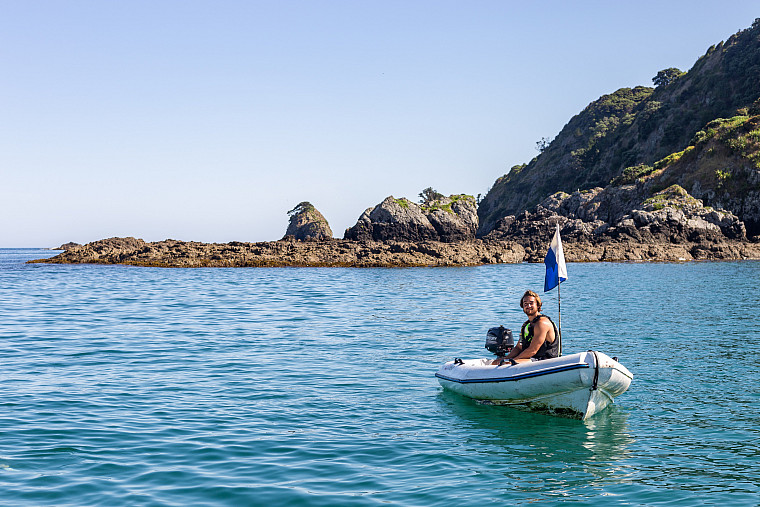Overseas and Off-Campus Programs Blog
Kina: The Unlikely Terror
Open gallery

Author Name
Author Program
Program Semester and Year
I counted steadily in my head “1, 2, 3, 4” as I walked back on the sand into the ocean, wearing the black, wetsuit and neon green headpiece provided by the dive shop. My fellow classmates were also doing this same exercise but they were counting for another reason. They were trying not to trip-up in their clunky flippers, whereas I was counting to prepare myself for the cold waters of the South Pacific Ocean at Cape Rodney-Okakari Point Marine Reserve off of Goat Island. I’ve had experience snorkelling and SCUBA diving back at home so I wasn’t too worried about tripping up. Instead, I had to mentally prepare myself for feeling the water surround my feet and rush into the small space between my skin and the wetsuit. Although realistically, the water wasn’t anywhere near ‘cold’, it was definitely no less than 20°C. It felt cold to me because I have a general distaste for water temperatures that aren’t close to the temperatures of my tropical homeland Barbados where the water averages about 26°C.
While snorkelling there were kelp forests for as far as my eye could see. It was surreal diving down and swimming through the kelp forests and encountering the several varied species of fish hiding within. In terms of the aquatic flora and fauna, I immediately noticed the stark difference between here and the waters in the Bay of Islands (not just the colder water temperatures!) where we had snorkelled just a few days earlier. In the Bay of Islands, kelp was completely absent from the landscape. The culprit responsible lay on the sea floor below us in clusters in the hundreds. At first glance, they seem pretty harmless due to their lack of movement, however, the kina (Evechinus chloroticus) is responsible for the decimation of ocean kelp forests. The kina is an endemic species of sea urchin and is the most common one in New Zealand. Reserves such as the one at Leigh are integral to the protection of several aquatic species, such as rock lobster, sea stars, snails, and snapper. These species are the main predators of the kina and help to keep the population at bay, without these predators, the kina can quickly overrun an area.
Cape Rodney-Okakari Point Marine Reserve is the first marine reserve to be established in New Zealand and it extends 800 metres offshore and stretches over 5 kilometres of coastline, effectively protecting 547 hectares. It is a “no-take” reserve which means there can be no fishing activity of any kind, and it is prohibited to collect flora and fauna within the boundary. In New Zealand, there are 37 similar marine reserves. These reserves protect against the harvesting/fishing of any marine life whatsoever. Without suffering from overfishing like several other areas in New Zealand, the kina’s natural predators are able to flourish and therefore keep their numbers down to virtually zero. I can personally testify to this because, during the hour spent snorkelling in the reserve, none of the people snorkelling saw any kina. This is an attestation to how effective these reserves are. Through solely preventing over-fishing, they allow the ecosystem to have an increase in bioproductivity and return to its previous state.
One might ask, why doesn’t the government just set up more of these marine reserves across the country, seeing as these reserves only protect 3% of New Zealand’s Exclusive Economic Zone. However, it’s not as simple as just declaring that certain areas are off limit to disturbance and fishing. There is a lot of behind the scenes politics and many government departments are at loggerheads over this issue. In order for new reserves to be opened, both the Ministry of Primary Industries (MPI) and Department of Conservation (DoC) must sign off on any parliamentary legislation. However, the issue with this is that the goals of these departments are not quite aligned. As the name suggests, the Department of Conservation is responsible for the preservation of historic sites, native endangered species and protection against pests. While the MPI is responsible for the enhancement and development of the country’s fishing industry, among other things. The main reason the MPI opposes the creation of new reserve areas is that will reduce the availability of fish for several fishermen and therefore could impact their livelihood. However, arguably overfishing is already reducing the amount of fish reaching mature stages which the fishermen can legally catch and sell. Due to this often-drawn-out political process, it takes an unreasonably long time to develop a new marine reserve area. The Department of Conservation has a goal of increasing the percentage of water areas protected from 3% to 10%, but at this rate, it seems likely that there is a long road ahead. Although the benefits of new reserves may seem obvious, the question becomes whether the government can balance the economic success of the country against the preservation of its ecosystems.
Overseas and Off-Campus Programs is located in room 206 of Albany Quadrangle on the Undergraduate Campus.
MSC: 11
email overseas@lclark.edu
voice 503-768-7295
fax 503-768-7300
Director Blythe Knott
Overseas and Off-Campus Programs
Lewis & Clark
615 S. Palatine Hill Road
Portland OR 97219